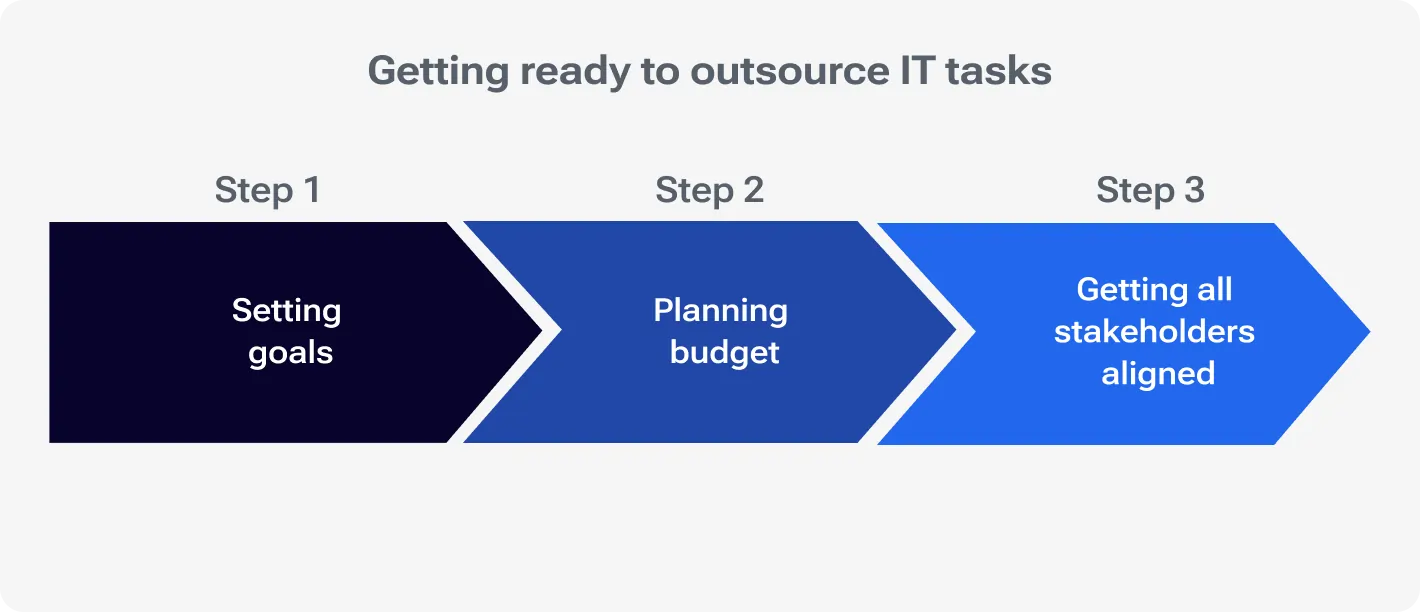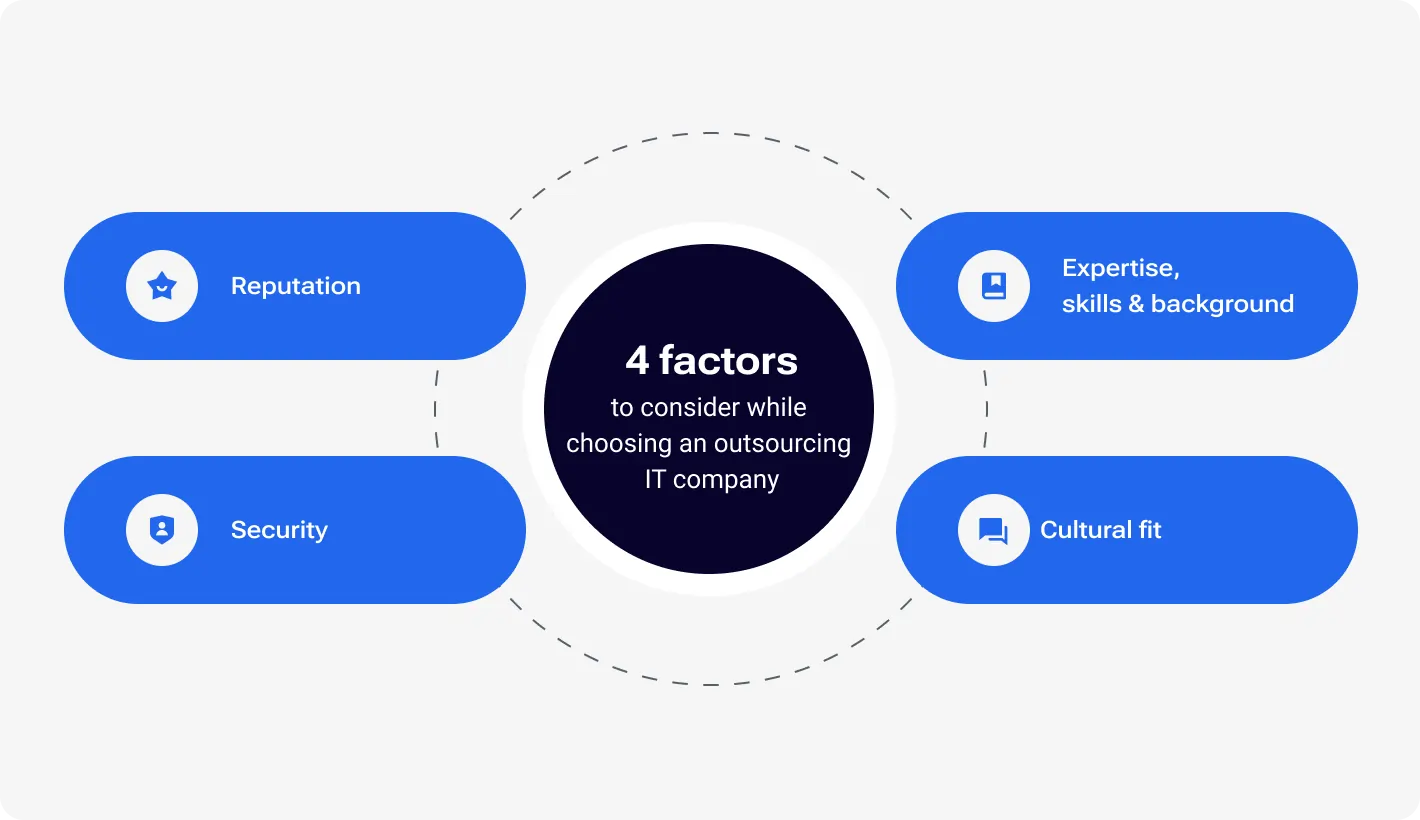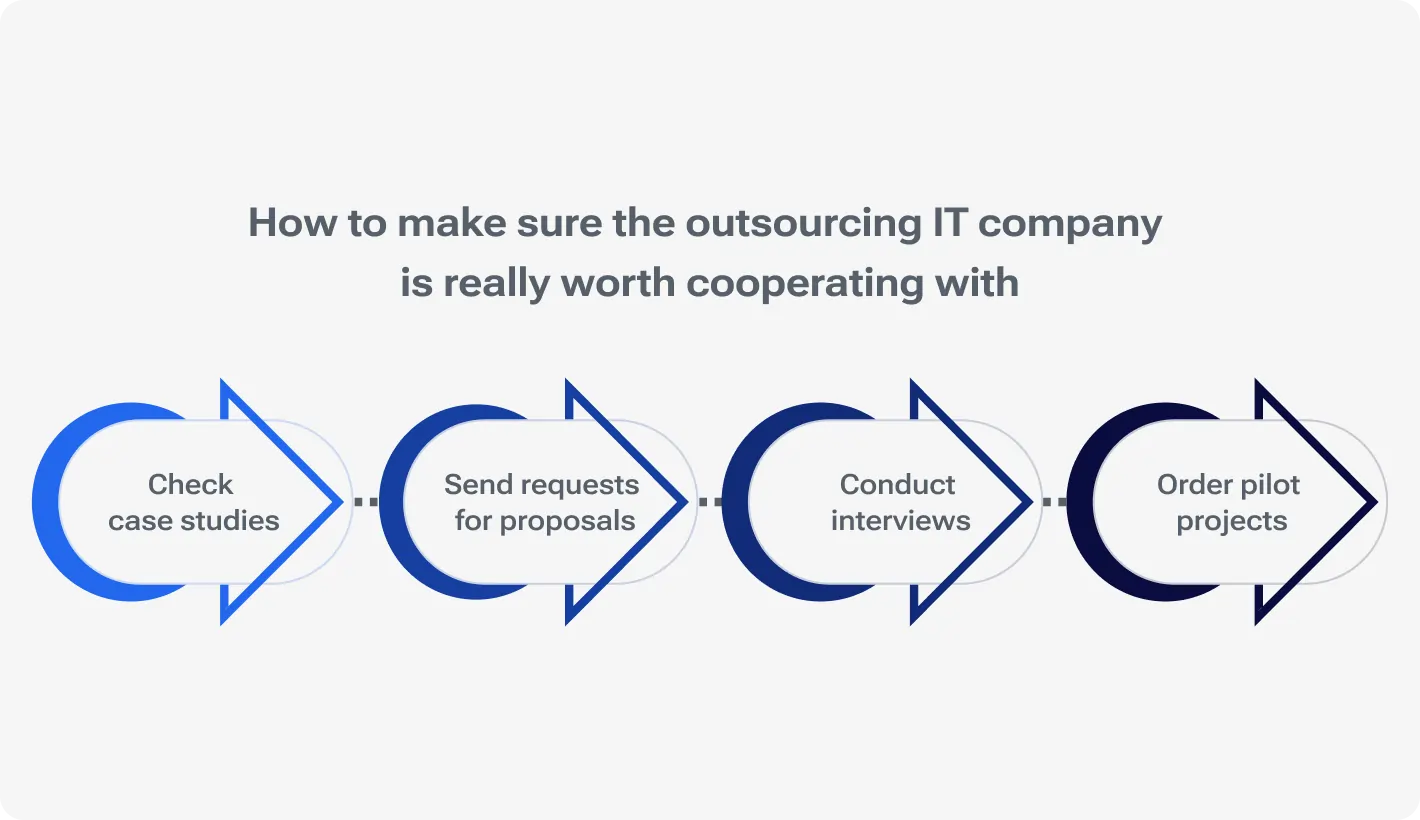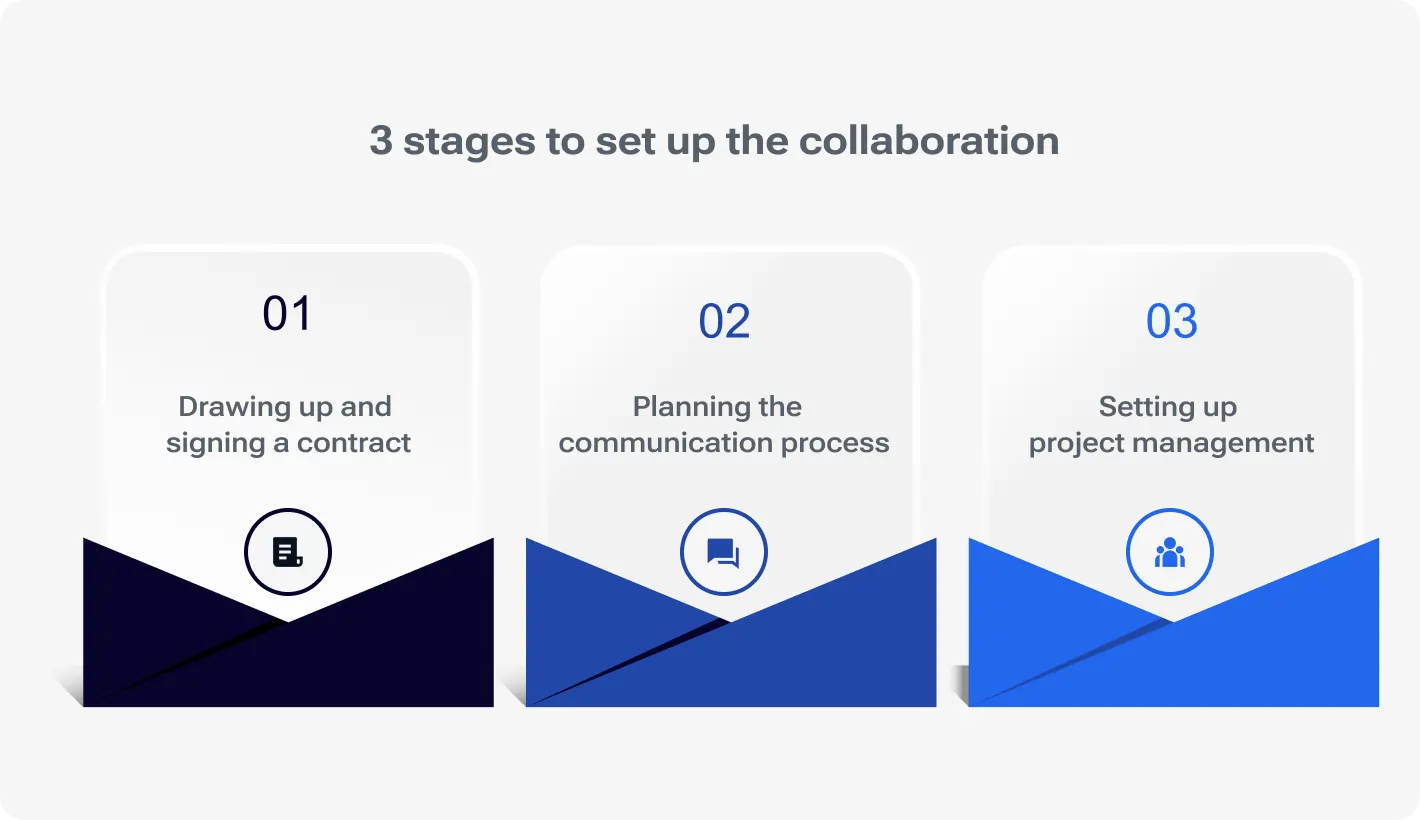Outsourcing software development is a very widespread practice with 37% of all IT operations globally being assigned to contractors. This working model can bring multiple benefits, such as shortening time to market, saving budget, and gaining more scalability.
Do you want to get all the advantages of this format but don’t know how to begin? In this article, you will find the A-to-Z guide to getting started with outsourcing: from estimating risks and making plans to signing a contract and managing your cooperation.
End-to-end solutions with predictable budgets, a time-to-market advantage with budget savings of up to 50%
Advantages vs risks: Evaluating the appropriateness of outsourcing
Before deciding on a partnership, you need to accurately define whether it will actually be beneficial. To do this, you need to thoroughly assess all the pros and cons. You can find the essential benefits and risks of assigning IT tasks to contractors in the table below.
Advantages and potential disadvantages of outsourcing
Benefits
Possible risks and how to avoid them
Saving budget. When cooperating with external IT teams, companies can get complex tasks completed at a lower rate. Moreover, businesses significantly save on HR costs. Total savings can reach as much as 70%, according to statistics from Forbes.
Not having enough control opportunities. Managing a remote outsourced team may be more complicated than an in-house one. However, with modern project management tools, regular meetings, and reports, it is possible to manage an outsourced team effectively.
Getting specific expertise instantly. Finding in-house specialists with skills and experience in specific areas, such as cybersecurity or blockchain, can take months. With outsourcing, companies can order the tasks you need right away, without wasting time on long searches and recruiting.
Communication barrier. It can be caused by many factors, such as different time zones or insufficient English language skills of external IT professionals. To overcome this, it is important to be responsible in choosing an outsourcing partner, and if necessary to use asynchronous methods of communication.
An opportunity to focus on core business operations. By outsourcing highly specialized IT tasks to external specialists, you can fully concentrate on achieving the main business goals, as all your in-house staff will only be engaged in key processes.
Security issues. Working with IT partners, businesses are handing over sensitive information to them. It is crucial to protect it. To avoid data leakage, it is essential to carefully select an IT company that adopts strict security measures, as well as to sign an NDA before starting to cooperate.
Becoming more scalable. This model of operation allows you to quickly increase and decrease the size of the project as needed. All you need to do for this is simply adjust the scope of the ordered tasks.
The risk of getting dependent on an IT outsourcing company. Sometimes companies may become unable to perform some critical functions without the help of their outsourcing partners. To avoid this, you need to ensure maintaining quality documentation, as well as data transfer between outsourced and in-house employees.
Getting ready to outsource: 3 steps to prepare
Onboarding outsourced teams: Tips for a smooth transition
After evaluating the pros and cons carefully, as well as thinking in advance about how to overcome possible risks, you can proceed to the next step: getting prepared for future cooperation with an external IT team. You can do this in 3 stages described below.
Step 1: Setting goals
Think about what exactly you would like to achieve with the help of outsourcing. For example, reducing costs by a certain sum, increasing productivity by an exact number of percent, completing a specific scope of tasks, etc.
Formulate an overall goal and divide it into smaller objectives. This way, you can create a plan for your future collaboration. It should include:
The scope of tasks that need to be accomplished.
Quality requirements (preferably with specific KPIs you are aiming for).
Deadlines for the entire project, as well as for specific parts of it if step-by-step completion and payment are planned.
The result of this step is creating such documents as:
Project charter. It contains the basic strategic business goal of the project and the reasons for its initiation.
Project roadmap. This is a general description of the project and its elements, such as objectives, milestones, deliverables, etc.
Statement of work. It describes the smaller objectives and tasks that need to be completed to achieve the overall goal.
Requirements. This is the document that includes information about the properties and features of the product that is going to be developed.
Specifications. It contains the technical details of what is described in the previous document and the quality standards to be adhered to in the process of work.
Step 2: Planning budget
When you already know exactly what you want to achieve and what services you need to order for this, plan a budget. To allocate enough resources, you need to include the costs for:
finding an outsourced partner (it requires research, interviews, and, sometimes, ordering a pilot project to try out collaboration);
managing an outsourced team.
Moreover, there can be some unexpected costs in case of force majeure. Therefore, take care to allocate some budget in advance to cover potential risks. Usually, +10-20% of the total budget is enough to set aside for contingencies.
Also, it is important to understand that post-deployment maintenance of the project may require some budget. So, make sure to keep this in mind while making your strategic plans for the future.
Step 3: Getting all stakeholders aligned
It is essential that all stakeholders of your business understand the benefits and possible risks of outsourcing, as well as have common views on the format of cooperation with partners. To reach a consensus on this topic, hold a joint discussion and involve all stakeholders in the planning process.
Also, to avoid cultural resistance and other problems within the company, get the in-house team prepared for future collaboration with external partners in advance. Tell them about:
The importance and business advantages of this.
What benefits it will bring them (e.g., freeing them from routine or overly complex tasks).
How the internal team will interact with the external specialists and how this will affect the overall workflow process.
Choosing the right partner for IT outsourcing: Best practices and criteria to consider
Finding the right partner will bring you halfway to success right away as the quality of the result depends on the conscientiousness and experience of the external team. What parameters to take into account when selecting an outsourcing partner? How properly assess whether a certain outsourcing company is suitable for you? Learn the answers to these questions below.
4 essential factors to consider while looking for the most appropriate partner
When searching for the ideal outsourcing IT company for cooperation, pay attention to the following most important points.
Expertise, skills, and background
Make sure the team has experts with the right qualifications to perform the tasks you need. For example, if you want to develop a mobile app, make sure the company has professionals specifically in Android and iOS development.
It's also worth paying attention to whether the specialists have experience in your business niche. Since many industries may have certain peculiarities, such as the need to comply with specific regulatory rules, it is important that the company has experience in that particular area.
If you are looking for professionals with expertise in specific narrow technologies, such as AI/ML or blockchain, you need to choose even more carefully. Make sure to check whether the company has successful cases of working with these particular things.
Reputation
This is one of the most important factors as it determines whether a given IT service provider is trustworthy or not. To check the reputation, research both the company's website and external independent sources.
Make sure that the majority of impressions from previous clients are positive. It would be perfect if you find video testimonials, as this format ensures that they are real.
Security
Since it is inevitable that you will be sharing confidential information with IT partners during the cooperation process, it is crucial to pay special attention to this point. Check whether the company uses modern and reliable security protocols to ensure the safety of all data.
Cultural fit
The skills and expertise of specialists are essential. However, they may turn out to be useless if the team is not culturally aligned with you.
It is important that you understand each other and have no barriers to communication. This will allow you to cooperate as effectively as possible and strive together for common goals.
How to determine if you have really found the right option
Just doing research and evaluating the information about the company is not enough. You also need to take some steps to evaluate potential partners in more detail. For this, you can do the following.
Check case studies
Look through the case studies that the company describes on its website. The more details about the role of the outsourcing team and the technologies used are described, the higher the expertise of the specialists is. And this is a good reason to trust them.
Send requests for proposals (RFPs)
To get the proposals from companies and be able to compare them, you need to reach out to potential partners with RFPs. In it, you need to describe:
the main information about your business (its industry, size, etc.);
the description of your planned project;
the timelines of project completion;
the deadline for replying to an RFP;
the criteria by which you are going to evaluate and select a partner for cooperation;
the date you are going to make your choice.
Once they have this information, companies will assess whether they can cooperate with you and will send you detailed partnership proposals.
Conduct interviews
An interview will be very useful in assessing the company’s communication style, as well as its employees’ English level. On it, you can also ask all your questions concerning cooperation with this IT service provider, for instance:
What experience and skills do the team members have? Are there any professionals with the expertise you need?
Does the company have successful cases in your niche?
What technologies and tools does the company use in its work?
How does the company handle the challenges and difficulties that may arise in the collaboration process?
What pricing policy does this IT service vendor offer?
How soon will the experts you need be ready to start working on your project?
Order pilot projects
If after interviewing all potential partners you still have a few options left and are in doubt, a test project will help you make the final decision. Think about a small number of real tasks and make a little short-term order. This will allow you to:
see the external IT team in action;
assess the company's communication style during the collaboration;
check whether the specialists comply with deadlines;
assess the quality of the finished work;
understand whether you and your partners are culturally compatible.
Setting up the collaboration: 3 stages to start the partnership
When you have made a final decision about what outsourcing company to choose, you need to prepare for long-term cooperation. There are only 3 steps on the way to a successful partnership. They are described below.
Drawing up and signing a contract
Prepare a clear and detailed agreement describing all the details of future cooperation. Be sure to include the information about:
the scope of services you are going to order;
the description of the tasks you need to be completed;
deadlines for the whole project and for each step of it if it consists of several parts;
rules for the storage and use of confidential information.
Also, pay attention to drafting SLAs (service level agreements) as a part of the contract. This document should contain details about the quality standards you expect the partners to meet. Be sure to express them as clearly as possible, and include the specific KPIs you are aiming for.
Planning the communication process
Discuss all the details regarding the interactions in the work process beforehand. Both you and your partner should designate staff members who will be responsible for communication. Also, you need to agree on the communication channels you are going to use and set up a schedule for meetings and reports.
Planning the communication process in advance will help both parties to keep aligned. It will also allow you to control the workflow more effectively. As a result, it will make the cooperation process as productive as possible.
Setting up project management
In order to avoid the risks associated with inadequate supervision, you need to decide how you will manage the work before you start the partnership. Select a convenient project management tool to unite the whole team and systematize the workflow. You can use task managers like Jira or Trello for this.
For effective control, define how often specialists must make updates on the current tasks in a project management tool. This will allow you to keep track of the whole workflow and the progress, always being aware of the stages each task is at. It will also give you the opportunity to resolve issues as quickly as possible if any arise.
Founding and maintaining the right relationship: From building trust to monitoring progress
For successful collaboration and quality results, it is vital to establish and maintain the right relationship with the IT service vendor and manage the workflow properly. How to do this? Read further in this article.
Establishing and maintaining trust
It's a crucial step for productive cooperation. To set and keep a trusting relationship, follow these tips:
Encourage open communication without reticence.
Make sure you provide all the information about your business needed for work.
Respect the cultural sensitivities of external professionals from other countries.
Avoid excessive negativity and blaming specific team members for failures.
Provide objective feedback on what can be improved for more effective task completion in the future.
Encourage a culture of admitting and correcting mistakes.
Use a transparent system of evaluating the work results.
Reward your partners for special achievements in terms of quality or speed of work.
Do not forget your external IT partners when you celebrate successes and do this together.
Keep an eye on the atmosphere in the team and eliminate conflicts early on.
Tracking performance
To maximize the quality of the final outcome, you need to monitor the progress constantly. Regular meetings and reports will help you in managing outsourcing relationships effectively. Agree on the frequency and schedule of calls and reports in advance and document this in the contract.
The ROI of outsourcing: Measuring success
Also, set KPIs and track their fulfillment. From time to time, conduct reviews to assess the results and suggest ways to improve. You can use the following 5 key metrics to monitor the performance of IT professionals.
5 most essential software development performance metrics
Metric
Its description
How it is measured
This rate helps to define the speed of work. This is the time it takes to complete a certain set of tasks.
Hours or days from the start of working on the tasks until their completion.
This metric reflects the speed and productivity of work.
Story points completed during a sprint.
This indicator represents the flexibility of the software development process.
Working hours or days it takes to fulfill the changes: from their initiation until their release to production.
This KPI shows the agility of the workflow.
Number of deployments within the specified period of time.
This metric helps to monitor the quality of code, as well as the productivity of QA engineers’ work.
The ratio between the number of defective lines of code to the total number of code lines.
Resolving issues
Beforehand, develop a plan for how you are going to deal with potential problems. In the contract, include the information about the penalties for failure to meet quality or deadlines.
Additionally, think about how you will resolve conflicts that may arise in the cooperation process. For example, mediation can be a good option. This is the involvement of a third, neutral party in resolving the conflict. It helps the two parties to the dispute to understand each other better and reach a consensus.
Ensuring success and evolving: How to improve continuously
To achieve the business goals successfully and increase revenues with the help of outsourcing, it is important to:
control the quality of work rigorously;
keep flexible and adaptable to market changes;
be open to innovation and constant improvement.
For this, use the following strategies.
1. Ensure a quality testing process
Some companies focus only on development but do not pay enough attention to testing. This can turn out to be a big mistake as the later you find bugs, the more expensive it will be to fix them. Therefore, it is very important to choose an IT outsourcing company that has not only highly skilled software developers but also top QA engineers.
2. Set effective feedback loops
Make sure to provide timely feedback on the work done. It should be detailed and objective. If there are some flaws, clearly express what is wrong and how to fix it. It is also crucial not to be overly accusatory and negative. Note the positives as well and use praise to increase the team morale.
3. Organize information exchange
Knowledge sharing between the outsourcing team and internal employees is very important. It's important that you share data with your partners, and they transfer their knowledge to you as well.
The first thing will help outsourcers better understand the peculiarities of your company’s operation and keep aligned with your business goals for better results. And the second one will help you with product maintenance and updates in the future.
4. Keep detailed documentation
Record all important aspects of the workflow, including:
decision-making peculiarities, and so on.
This will help each team member understand the structure of the workflow. Also, this can boost your scalability as it will be easier to onboard new specialists.
Real-life case studies of productive outsourcing
Are you still in doubt whether it is a good idea to turn to an external IT team? Here are some stories of successful partnerships to inspire you.
General Electric
An American giant in the electric power, machinery, and aerospace industries has been using the work of contractors to complete manufacturing, IT, and customer service tasks since the early 2000s. This allowed them to outperform their competitors by:
achieving goals more efficiently by fully focusing internal employees on core business processes.
Lesson learned: Outsourcing not only reduces costs but also has many other benefits, such as increasing productivity and freeing internal employees from routine tasks in favor of more global ones.
WhatsApp
One of the world's most popular messengers used to be a small startup with 30 employees in 2012. It had a limited budget but did not want to sacrifice quality in favor of cheapness.
To achieve the perfect balance of price and quality, it decided to turn to highly qualified outsourced engineers from Eastern Europe. The results of their work were so good that the product became extremely popular and now has almost 3 billion monthly active users.
Lesson learned: Outsourcing can be an ideal solution for small businesses and startups as they can get quality work done even with a limited budget.
Abbott Laboratories
A leading American healthcare company set a goal to speed up development processes and release code more often. However, doing it without loss in quality turned out to be a challenge.
But outsourcing specialists from Devico have helped them with this. They have developed an automated testing system that has reduced the time to conduct smoke tests by 7 times. This gave an opportunity to send code to release faster and more frequently, while still providing high-quality testing.
Lesson learned: Testing is as important as development because it ensures the high quality of a product. A good outsourcing company with top QA professionals can help a business optimize this phase of workflow.
Conclusion
Outsourcing has many benefits, such as accelerating processes, optimizing budget, increasing flexibility, etc. To make your cooperation as productive as possible, you need to complete a few steps described above in the article:
-
assess the advantages and risks;
-
set the goals;
-
outline the project;
-
plan your budget;
-
get all stakeholders aligned;
-
find the right outsourcing company;
-
draw up and sign a contract;
-
plan the communication process;
-
set up project management;
-
establish and maintain a trusting relationship;
-
make a plan for issue resolution;
-
set and monitor KPIs;
-
organize the effective quality assurance process;
-
keep comprehensive documentation;
-
ensure knowledge transfer.
Are you on the sixth step now, looking for the right IT outsourcing partner? Contact Devico to learn the details about our specialists, tools, workflow organization, communication culture, and pricing policy.
Support your business growth with a global talent pool of experienced software engineers







